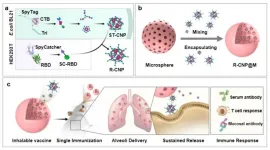Recent developments at MD Anderson include a novel blood-based test to predict lung cancer relapses, improved detection of genes associated with complex traits, insights into how B cell activity influences immunodeficiency, novel targets that drive treatment resistance in pancreatic tumors, a triple combination for treatment-resistant acute myeloid leukemia, a DNA damage avoidance pathway involved in chemotherapy resistance, genomic insights to help risk stratification in patients with chondrosarcomas, and a new therapeutic target for non-alcoholic liver disease.
Circulating tumor DNA and imaging aid in predicting operable lung cancer relapse risk
Early-stage non-small cell lung cancer (NSCLC) has a 33%-60% five-year survival rate post-surgery, but predicting the risk of relapse remains challenging. In a retrospective study, John Heymach, M.D., Ph.D., and colleagues found that combining a circulating tumor DNA (ctDNA) analysis with tumor volume measurement significantly improved relapse prediction versus ctDNA analysis alone. Among 85 patients with early-stage NSCLC who underwent plasma sampling and were followed for 4.3 years, 39% experienced a relapse. Persistent ctDNA was correlated with shorter relapse-free survival (RFS) and overall survival (OS) versus undetectable ctDNA. Integrating radiological tumor volume significantly improved risk prediction for those with larger baseline tumors and detectable ctDNA. This study underscores the potential of using blood-based ctDNA analyses along with radiological tumor information as biomarkers to personalize treatments and to improve predictions of RFS and OS after surgery in patients with NSCLC. Learn more in Annals of Oncology.
New GWAS method improves understanding and prediction of complex traits
Genome-wide association studies (GWAS) are helpful in identifying genes associated with complex traits, but they only capture a fraction of potential targets since they rely on total gene expression and can miss underlying molecular mechanisms. To further increase their potential, researchers led by Arjun Battacharya, Ph.D., used an approach called isoform-level transcriptome-wide association (isoTWAS), which allows for the detection of differentially spliced genes, or isoforms. This approach combines genetics, isoform-level expression and phenotype associations. Using this method on data collected from GWAS for 15 neuropsychiatric traits, the researchers uncovered associations at over 60% more locations and improved prediction accuracy compared to GWAS models. They also doubled the number of features that can be tested for mapping traits and provided a better understanding of underlying mechanisms of gene expression and splicing. The study highlights the usefulness of isoforms to further discover the molecular mechanisms associated with physical traits. Learn more in Nature Genetics.
CD19 activity in B cells influences immunodeficiency in ICF syndrome
Immunodeficiency, centromeric instability and facial anomalies (ICF) syndrome is a genetic disorder marked by DNA hypomethylation and antibody deficiencies that can lead to recurrent and often fatal infections. Previous studies have shown patients with ICF syndrome do not have memory B cells and plasma cells, but it is unclear why. To uncover molecular pathways involved, researchers led by Kevin McBride, Ph.D., and Taiping Chen, Ph.D., examined mutations in ZBTB24 – one of four known genes that cause ICF – and CD19, a protein expressed throughout B cell development. Lab models without ZBTB24 had the same characteristics of ICF syndrome, and their B cells had elevated CD19 phosphorylation, which contributed to low antibodies. The researchers identified several molecular components resulting in DNA hypomethylation and enhanced CD19 phosphorylation, highlighting potential therapeutic targets for patients with ICF syndrome. Learn more in Cellular & Molecular Immunology.
Combination therapy highlights mediators of treatment resistance in pancreatic tumors
Immune checkpoint blockade does not work well in patients with pancreatic cancer, partly due to tumor hypoxia, or lack of oxygen, which limits the immune response. A previous study led by Michael Curran, Ph.D., showed that ablating tumor hypoxia can sensitize cancer to immunotherapy. Combining the hypoxia-activated drug TH-302 with VEGFR-2 blockade can enhance the immune response and restore T cell infiltration in neuroblastoma models, but their effects in pancreatic cancer are unknown. In this study, researchers used lab models to examine the impact of TH-302 and VEGFR-2 blockade on the pancreatic cancer tumor microenvironment. The combination increased DNA damage and improved survival over monotherapy, but adding immunotherapy did not improve responses. However, the researchers noted that the combination led to more infiltration by immunosuppressive granulocytic myeloid-derived suppressor cells, suggesting these cells adapted as potential key mediators of treatment resistance and could serve as additional therapeutic targets. Learn more in JCI Insight.
Triple combination therapy overcomes venetoclax resistance in acute myeloid leukemias
Patients with relapsed or refractory acute myeloid leukemia (AML), especially those who don’t respond or develop resistance to venetoclax-based therapies, have poor survival outcomes. TP53 is a key mediator of cell death in AML cells following venetoclax treatment, but it frequently is inactivated by negative regulator MDM2 and transporter protein XPO1. To reactivate TP53 transcription, Yuki Nishida, M.D., Ph.D., and Michael Andreeff, M.D., Ph.D., combined MDM2 and XPO1 inhibitors in laboratory models of venetoclax-resistant AML. While the dual combination prolonged survival, it also led to quiescence – in which cells stop replicating and avoid apoptosis. This prompted the researchers to consider adding venetoclax. The triple combination significantly decreased the leukemia burden and prolonged survival in vivo by 300% through effectively killing quiescent AML cells. This study provides evidence to support further clinical investigations aimed at improving outcomes in patients with venetoclax-resistant AML. Learn more in Science Advances.
Key mediator in DNA damage avoidance pathway protects against chemotherapy
Type II isomerases (TOP2) play a critical role in DNA replication and chromosome separation by cutting both strands of DNA simultaneously. Interfering with this activity using TOP2 poisons, such as the anti-cancer agent etoposide (ETO), generates DNA damage and can be an effective chemotherapy strategy. These breaks usually are repaired via non-homologous end joining or homologous recombination, but those processes can fail, leading to genome instability and cytotoxicity, especially when encountering TOP2 that is trapped by ETO. To further understand how TOP2 is regulated and how these trapped TOP2 ends are removed, researchers led by Junjie Chen, Ph.D., performed whole-genome CRISPR-Cas9 screening with ETO treatment. They identified RAD54L2 as a key mediator of ETO resistance, reducing DNA damage and preserving genomic stability by preventing excess binding of TOP2 and reducing its trapped form. The study suggests that this conserved TOP2-specific pathway to avoid DNA damage is critical in maintaining genomic stability and could be a therapeutic target. Learn more in Science Advances.
Genomic profiling links TP53 mutations with poorer outcomes in chondrosarcomas
Chondrosarcoma, the most common bone cancer, derives from cartilage and often has mutations in the IDH1, IDH2 and TP53 genes, but little is known about the clinical implication of these mutations. To understand their prognostic and predictive value, researchers led by Ryan Denu, Ph.D., and Anthony Conley, M.D., analyzed mutations in IDH1, IDH2, TP53 and other genes using data from 93 patients with conventional and dedifferentiated chondrosarcoma. IDH1 and IDH2 mutations were the most prevalent (50.5%) and were associated with a higher age at diagnosis. They also were found more commonly in cancers of the extremities and in dedifferentiated rather than conventional chondrosarcomas. TP53 mutations were present in 41.9% of patients, were more common in dedifferentiated chondrosarcomas, and were associated with poorer overall and metastasis-free survival and a higher risk of recurrence after surgery. These insights could inform therapeutic strategies and risk stratification for patients with chondrosarcoma. Learn more in Clinical Cancer Research.
Specific TP53 mutation drives tumor progression and metastasis in liver cancer
Non-alcoholic fatty liver disease (NAFLD) and non-alcoholic steatohepatitis (NASH) are known risk factors for hepatocellular carcinoma, the most common liver cancer, and usually are associated with obesity and diabetes. TP53, the most frequently mutated gene in cancer, is known to contribute to tumor progression, but the role of specific TP53 mutations remains unknown. To provide further insights, researchers led by Denada Dibra, Ph.D., and Guillermina Lozano, Ph.D., generated lab models without TP53 and models with a specific TP53 hotspot mutation, p53R245W, in liver cells. Following a high-fat diet, which induces obesity and mimics NASH in the models, those with the p53R245W mutation had increased fatty liver and cell proliferation and showed increased expression of tumor-promoting pathways compared to control models. The mutation also tripled the incidence of metastasis compared to models with TP53 loss. The study suggests that p53R245W is a potential therapeutic target for patients with NASH. Learn more in Cancer Research Communications.
Awards and honors
Jeffrey Siewerdsen, Ph.D., professor of Imaging Physics, and Anil Sood, M.D., professor of Gynecologic Oncology and Reproductive Medicine, were inducted as Fellows to the National Academy of Inventors Dimitrios Kontoyiannis, M.D., Ph.D., deputy division head of Internal Medicine, was awarded the American College of Physicians Harriet P. Dustan Award In case you missed it
Read below to catch up on recent MD Anderson press releases.
ASH: Novel combination therapy significantly reduces spleen volume in patients with myelofibrosis ASH: Targeted oral therapy reduced disease burden and improved symptoms for patients with rare blood disorder ASH: Novel menin inhibitors show promise for patients with advanced acute myeloid leukemia SABCS: Combining ribociclib with hormone therapy improved patient outcomes in early-stage breast cancer MD Anderson and Rigel Pharmaceuticals announce strategic alliance to advance olutasidenib in AML and other cancers SABCS: Studies suggest novel targeted therapies may benefit patients with metastatic HR+/ HER2- breast cancer MD Anderson Research Highlights: ASH 2023 Special Edition MD Anderson, TACC and the Oden Institute announce funding for the next round of collaborative cancer research projects MD Anderson’s Katy Rezvani, M.D., receives 2023 Honorific Award from the American Society of Hematology Eating beans improves gut health, regulates immune and inflammatory processes in colorectal cancer survivors New combination improves radiation therapy outcomes in patients with locally advanced and borderline resectable pancreatic cancer Read this press release in the MD Anderson Newsroom.
– 30 –
END






